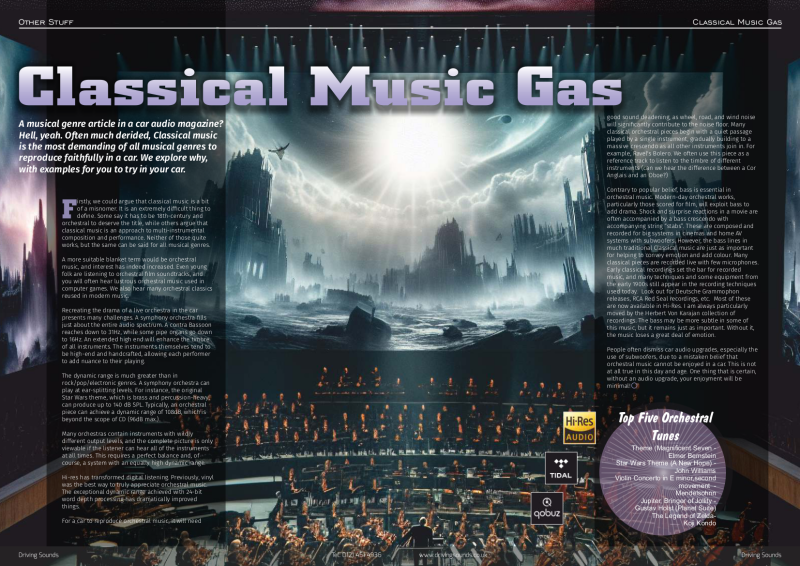
Classical Music Gas
A musical genre article in a car audio magazine? Hell, yeah. Often much derided, Classical music is the most demanding of all musical genres to reproduce faithfully in a car. We explore why, with examples for you to try in your car.
Firstly, we could argue that classical music is a bit of a misnomer. It is an extremely difficult thing to define. Some say it has to be 18th-century and orchestral to deserve the title, while others argue that classical music is an approach to multi-instrumental composition and performance. Neither of those quite works, but the same can be said for all musical genres.
A more suitable blanket term would be orchestral music, and interest has indeed increased. Even young folk are listening to orchestral film soundtracks, and you will often hear lustrous orchestral music used in computer games. We also hear many orchestral classics reused in modern music.
Recreating the drama of a live orchestra in the car presents many challenges. A symphony orchestra fills just about the entire audio spectrum. A contra Bassoon reaches down to 31Hz, while some pipe organs go down to 16Hz. An extended high end will enhance the timbre of all instruments. The instruments themselves tend to be high-end and handcrafted, allowing each performer to add nuance to their playing.
The dynamic range is much greater than in rock/pop/electronic genres. A symphony orchestra can play at ear-splitting levels. For instance, the original Star Wars theme, which is brass and percussion-heavy, can produce up to 140 dB SPL. Typically, an orchestral piece can achieve a dynamic range of 108dB, which is beyond the scope of CD (96dB max.).
Many orchestras contain instruments with wildly different output levels, and the complete picture is only viewable if the listener can hear all of the instruments at all times. This requires a perfect balance and, of course, a system with an equally high dynamic range.
Hi-res has transformed digital listening. Previously, vinyl was the best way to truly appreciate orchestral music. The exceptional dynamic range achieved with 24-bit word depth processing has dramatically improved things.
For a car to reproduce orchestral music, it will need good sound deadening, as wheel, road, and wind noise will significantly contribute to the noise floor. Many classical orchestral pieces begin with a quiet passage played by a single instrument, gradually building to a massive crescendo as all other instruments join in. For example, Ravel’s Bolero. We often use this piece as a reference track to listen to the timbre of different instruments (can we hear the difference between a Cor Anglais and an Oboe?)
Contrary to popular belief, bass is essential in orchestral music. Modern-day orchestral works, particularly those scored for film, will exploit bass to add drama. Shock and surprise reactions in a movie are often accompanied by a bass crescendo with accompanying string “stabs”. These are composed and recorded for big systems in cinemas and home AV systems with subwoofers. However, the bass lines in much traditional Classical music are just as important for helping to convey emotion and add colour. Many classical pieces are recorded live with few microphones. Early classical recordings set the bar for recorded music, and many techniques and some equipment from the early 1900s still appear in the recording techniques used today. Look out for Deutsche Grammophon releases, RCA Red Seal recordings, etc. Most of these are now available in Hi-Res. I am always particularly moved by the Herbert Von Karajan collection of recordings. The bass may be more subtle in some of this music, but it remains just as important. Without it, the music loses a great deal of emotion.
People often dismiss car audio upgrades, especially the use of subwoofers, due to a mistaken belief that orchestral music cannot be enjoyed in a car. This is not at all true in this day and age. One thing that is certain, without an audio upgrade, your enjoyment will be minimal!
Top Five Orchestral Tunes
Theme (The Magnificent Seven) – Elmer Bernstein
Star Wars Theme (A New Hope) - John Williams
Violin Concerto in E minor, second movement - Mendelsohnn
Jupiter, Bringer of Jollity – Gustav Holst (Planet Suite)
The Legend of Zelda – Koji Kondo
Find out what our partner, The FOUR MASTER Network, can do to bring Hi-Fi quality to your car. Simply put some brief details into the form below.
Not ready for that yet? You can use the same form to book a demonstration at your home, place of work or with your local FOUR MASTER
